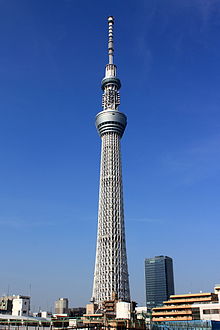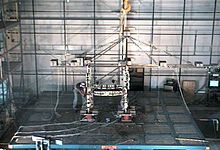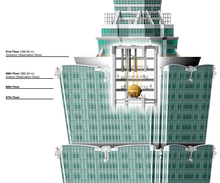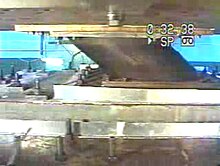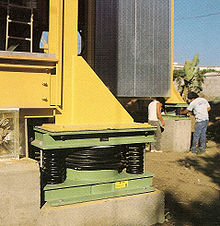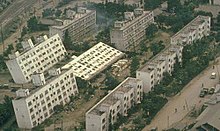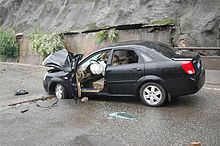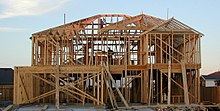भूकम्प वास्तुविद्या is an अंतःविषय branch of engineering that designs and analyzes structures, such as buildings and bridges, with भूकंप in mind. Its overall goal is to make such structures more resistant to earthquakes. An earthquake (or seismic) engineer aims to construct structures that will not be damaged in minor shaking and will avoid serious damage or collapse in a major earthquake. Earthquake engineering is the scientific field concerned with protecting society, the natural environment, and the man-made environment from earthquakes by limiting the भूकंपीय जोखिम to सामाजिक-आर्थिक रूप से acceptable levels.1 Traditionally, it has been narrowly defined as the study of the behavior of structures and geo-structures subject to भूकंपीय लोडिंग; it is considered as a subset of संरचनागत वास्तुविद्या, भू - तकनीकी इंजीनियरिंग, मैकेनिकल इंजीनियरिंग, केमिकल इंजीनियरिंग, अनुप्रयुक्त भौतिकी, etc. However, the tremendous costs experienced in recent earthquakes have led to an expansion of its scope to encompass disciplines from the wider field of असैनिक अभियंत्रण, मैकेनिकल इंजीनियरिंग, नाभिकीय अभियांत्रिकी, and from the सामाजिक विज्ञान, especially समाज शास्त्र, राजनीति विज्ञान, अर्थशास्त्र, and वित्त.2
भूकंप इंजीनियरिंग के मुख्य उद्देश्य हैं:
Foresee the potential consequences of strong भूकंप on शहरी क्षेत्र and civil infrastructure.
Design, construct and maintain structures to प्रदर्शन at earthquake exposure up to the expectations and in compliance with बिल्डिंग कोड.3
A ठीक से इंजीनियर संरचना does not necessarily have to be extremely strong or expensive. It has to be properly designed to withstand the seismic effects while sustaining an acceptable level of damage.
भूकंपीय लोडिंग
भूकंपीय लोडिंग means application of an earthquake-generated excitation on a structure (or geo-structure). It happens at contact surfaces of a structure either with the ground,5 with adjacent structures,6 or with गुरुत्वाकर्षण तरंगें from सुनामी. The loading that is expected at a given location on the Earth's surface is estimated by engineering भूकंप विज्ञान. It is related to the भूकंपीय खतरा of the location.
भूकंपीय प्रदर्शन
भूकंप or भूकंपीय प्रदर्शन defines a structure's ability to sustain its main functions, such as its सुरक्षा and उपयुक्तता, पर and उपरांत a particular earthquake exposure. A structure is normally considered सुरक्षित if it does not endanger the lives and अच्छा-हो रहा है of those in or around it by partially or completely collapsing. A structure may be considered फ़ायदेमंद if it is able to fulfill its operational functions for which it was designed.
भूकंप इंजीनियरिंग की बुनियादी अवधारणाएं, प्रमुख बिल्डिंग कोड में लागू की गई हैं, यह मानती हैं कि एक इमारत को एक दुर्लभ, बहुत गंभीर भूकंप में महत्वपूर्ण क्षति को बनाए रखना चाहिए, लेकिन विश्व स्तर पर ढहने के बिना।7 On the other hand, it should remain operational for more frequent, but less severe seismic events.
भूकंपीय प्रदर्शन मूल्यांकन
इंजीनियरों को वास्तविक या प्रत्याशित भूकंपीय प्रदर्शन के परिमाणित स्तर को जानने की आवश्यकता होती है, जो किसी विशिष्ट भवन को सीधे नुकसान से जुड़ा होता है, जो एक निर्दिष्ट जमीनी झटकों के अधीन होता है। ऐसा मूल्यांकन प्रयोगात्मक या विश्लेषणात्मक रूप से किया जा सकता है।
प्रायोगिक मूल्यांकन
Experimental evaluations are expensive tests that are typically done by placing a (scaled) model of the structure on a शेक-टेबल that simulates the earth shaking and observing its behavior.8 Such kinds of experiments were first performed more than a century ago.9 Only recently has it become possible to perform 1:1 scale testing on full structures.
इस तरह के परीक्षणों की महंगी प्रकृति के कारण, उनका उपयोग मुख्य रूप से संरचनाओं के भूकंपीय व्यवहार को समझने, मॉडल को मान्य करने और विश्लेषण विधियों को सत्यापित करने के लिए किया जाता है। इस प्रकार, एक बार उचित रूप से मान्य होने के बाद, कम्प्यूटेशनल मॉडल और संख्यात्मक प्रक्रियाएं संरचनाओं के भूकंपीय प्रदर्शन मूल्यांकन के लिए प्रमुख बोझ वहन करती हैं।
विश्लेषणात्मक / संख्यात्मक मूल्यांकन
भूकंपीय प्रदर्शन मूल्यांकन or भूकंपीय संरचनात्मक विश्लेषण is a powerful tool of earthquake engineering which utilizes detailed modelling of the structure together with methods of structural analysis to gain a better understanding of seismic performance of building and गैर-भवन संरचनाएं. औपचारिक अवधारणा के रूप में तकनीक अपेक्षाकृत हालिया विकास है।
In general, seismic structural analysis is based on the methods of संरचनात्मक गतिकी.10 For decades, the most prominent instrument of seismic analysis has been the earthquake प्रतिक्रिया स्पेक्ट्रम method which also contributed to the proposed building code's concept of today.11
However, such methods are good only for linear elastic systems, being largely unable to model the structural behavior when damage (i.e., गैर-रैखिकता) appears. Numerical चरण-द्वारा-चरण एकीकरण proved to be a more effective method of analysis for multi-degree-of-freedom संरचनात्मक प्रणाली with significant गैर-रैखिकता under a क्षणिक process of ground motion excitation.12 Use of the सीमित तत्व विधि is one of the most common approaches for analyzing non-linear मिट्टी की संरचना बातचीत computer models.
मूल रूप से, इमारतों के भूकंपीय प्रदर्शन का मूल्यांकन करने के लिए संख्यात्मक विश्लेषण किया जाता है। प्रदर्शन मूल्यांकन आम तौर पर गैर-रेखीय स्थैतिक पुशओवर विश्लेषण या गैर-रेखीय समय-इतिहास विश्लेषण का उपयोग करके किया जाता है। ऐसे विश्लेषणों में, बीम, कॉलम, बीम-स्तंभ जोड़ों, कतरनी दीवारों आदि जैसे संरचनात्मक घटकों के सटीक गैर-रैखिक मॉडलिंग को प्राप्त करना आवश्यक है। इस प्रकार, प्रयोगात्मक परिणाम निर्धारित करने में एक महत्वपूर्ण भूमिका निभाते हैं। व्यक्तिगत घटकों के मॉडलिंग पैरामीटर, विशेष रूप से वे जो महत्वपूर्ण गैर -रैखिक विकृतियों के अधीन हैं। व्यक्तिगत घटकों को तब संरचना का एक पूर्ण गैर -रैखिक मॉडल बनाने के लिए इकट्ठा किया जाता है। इस प्रकार निर्मित मॉडलों का विश्लेषण भवनों के प्रदर्शन का मूल्यांकन करने के लिए किया जाता है।
The capabilities of the structural analysis software are a major consideration in the above process as they restrict the possible component models, the analysis methods available and, most importantly, the numerical robustness. The latter becomes a major consideration for structures that venture into the non-linear range and approach global or local collapse as the numerical solution becomes increasingly unstable and thus difficult to reach. There are several commercially available Finite Element Analysis software's such as CSI-SAP2000 and CSI-PERFORM-3D, MTR/SASSI, Scia Engineer-ECtools, ABAQUS, and Ansys, all of which can be used for the seismic performance evaluation of buildings. Moreover, there is research-based finite element analysis platforms such as ओपनसीज़, MASTODON, which is based on the मूस फ्रेमवर्क, RUAUMOKO और पुराने DRAIN-2D/3D, जिनमें से कई अब खुले स्रोत हैं।
भूकंप इंजीनियरिंग के लिए अनुसंधान
भूकंप इंजीनियरिंग के लिए अनुसंधान का अर्थ है भूकंप इंजीनियरिंग से संबंधित तथ्यों की खोज और वैज्ञानिक स्पष्टीकरण के लिए क्षेत्र और विश्लेषणात्मक जांच या प्रयोग, नए निष्कर्षों के आलोक में पारंपरिक अवधारणाओं का संशोधन, और विकसित सिद्धांतों के व्यावहारिक अनुप्रयोग।
The राष्ट्रीय विज्ञान संस्था (NSF) is the main United States government agency that supports fundamental research and education in all fields of earthquake engineering. In particular, it focuses on experimental, analytical and computational research on design and performance enhancement of structural systems.
The भूकंप इंजीनियरिंग अनुसंधान संस्थान (EERI) is a leader in dissemination of भूकंप इंजीनियरिंग अनुसंधान related information both in the U.S. and globally.
A definitive list of earthquake engineering research related मिलाते हुए टेबल around the world may be found in Experimental Facilities for Earthquake Engineering Simulation Worldwide.14 The most prominent of them is now E-Defense Shake Table15 in जापान.
प्रमुख अमेरिकी अनुसंधान कार्यक्रम
NSF also supports the George E. Brown, Jr. भूकंप इंजीनियरिंग सिमुलेशन के लिए नेटवर्क
The NSF Hazard Mitigation and Structural Engineering program (HMSE) supports research on new technologies for improving the behaviour and response of structural systems subject to earthquake hazards; fundamental research on safety and reliability of constructed systems; innovative developments in विश्लेषण and model based simulation of structural behaviour and response including soil-structure interaction; design concepts that improve संरचना प्रदर्शन and flexibility; and application of new control techniques for structural systems.16
(NEES) that advances knowledge discovery and innovation for भूकंप and सुनामी loss reduction of the nation's civil infrastructure and new experimental simulation techniques and instrumentation.17
एनईईएस नेटवर्क में 14 भौगोलिक रूप से-वितरित, साझा-प्रयोगशालाएं हैं जो कई प्रकार के प्रयोगात्मक कार्यों का समर्थन करती हैं:17 geotechnical centrifuge research, शेक-टेबल tests, large-scale structural testing, tsunami wave basin experiments, and field site research.18 Participating universities include: कर्नेल विश्वविद्यालय; लेह विश्वविद्यालय; ओरेगन स्टेट यूनिवर्सिटी; Rensselaer पॉलिटेक्निक संस्थान; बफ़ेलो में विश्वविद्यालय, स्टेट यूनिवर्सिटी ऑफ़ न्यू यॉर्क; यूनिवर्सिटी ऑफ कैलिफोर्निया, बर्केले; कैलिफोर्निया विश्वविद्यालय, डेविस; कैलिफोर्निया विश्वविद्यालय, लॉस एंजिल्स; कैलिफोर्निया विश्वविद्यालय, सैन डिएगो; कैलिफोर्निया विश्वविद्यालय, सांता बारबरा; इलिनोइस विश्वविद्यालय, अर्बाना-शैंपेन; मिनेसोटा विश्वविद्यालय; नेवादा विश्वविद्यालय, रेनो; and the टेक्सास विश्वविद्यालय, ऑस्टिन.17
The equipment sites (labs) and a central data repository are connected to the global earthquake engineering community via the NEEShub website. The NEES website is powered by HUBzero software developed at पर्ड्यू विश्वविद्यालय for नैनोहब specifically to help the scientific community share resources and collaborate. The cyberinfrastructure, connected via इंटरनेट2, इंटरैक्टिव सिमुलेशन टूल, एक सिमुलेशन टूल डेवलपमेंट एरिया, एक क्यूरेटेड सेंट्रल डेटा रिपोजिटरी, एनिमेटेड प्रेजेंटेशन, यूजर सपोर्ट, टेलीप्रेजेंस, संसाधनों को अपलोड करने और साझा करने के लिए तंत्र, और उपयोगकर्ताओं और उपयोग पैटर्न के बारे में आंकड़े प्रदान करता है।
यह साइबर इन्फ्रास्ट्रक्चर शोधकर्ताओं को अनुमति देता है: एक केंद्रीय स्थान में एक मानकीकृत ढांचे के भीतर डेटा को सुरक्षित रूप से संग्रहीत, व्यवस्थित और साझा करें; समन्वयित वास्तविक-समय डेटा और वीडियो के उपयोग के माध्यम से दूरस्थ रूप से निरीक्षण करें और प्रयोगों में भाग लें; अनुसंधान प्रयोगों की योजना, प्रदर्शन, विश्लेषण और प्रकाशन की सुविधा के लिए सहयोगियों के साथ सहयोग करना; और कम्प्यूटेशनल और हाइब्रिड सिमुलेशन का संचालन करते हैं जो कई वितरित प्रयोगों के परिणामों को जोड़ सकते हैं और समग्र सिस्टम प्रदर्शन की जांच को सक्षम करने के लिए कंप्यूटर सिमुलेशन के साथ भौतिक प्रयोगों को जोड़ सकते हैं।
ये संसाधन संयुक्त रूप से नागरिक और यांत्रिक अवसंरचना प्रणालियों के भूकंपीय डिजाइन और प्रदर्शन में सुधार के लिए सहयोग और खोज के साधन प्रदान करते हैं।
भूकंप सिमुलेशन
The very first भूकंप सिमुलेशन were performed by statically applying some क्षैतिज जड़ता बल based on परतदार पीक ग्राउंड त्वरण to a mathematical model of a building.19 With the further development of computational technologies, स्थिर approaches began to give way to गतिशील ones.
Dynamic experiments on building and non-building structures may be physical, like शेक-टेबल टेस्टिंग, or virtual ones. In both cases, to verify a structure's expected seismic performance, some researchers prefer to deal with so called "real time-histories" though the last cannot be "real" for a hypothetical earthquake specified by either a building code or by some particular research requirements. Therefore, there is a strong incentive to engage an earthquake simulation which is the seismic input that possesses only essential features of a real event.
कभी-कभी भूकंप सिमुलेशन को एक मजबूत भूकंप के स्थानीय प्रभावों के पुन: -सृजन के रूप में समझा जाता है।
संरचना अनुकरण
Theoretical or experimental evaluation of anticipated seismic performance mostly requires a संरचना अनुकरण which is based on the concept of structural likeness or similarity. समानता is some degree of समानता or सादृश्य between two or more objects. The notion of similarity rests either on exact or approximate repetitions of पैटर्न्स in the compared items.
In general, a building model is said to have similarity with the real object if the two share ज्यामितीय समानता, गतिज समानता and गतिशील समानता. The most vivid and effective type of similarity is the कीनेमेटीक्स का one. गतिज समानता exists when the paths and velocities of moving particles of a model and its prototype are similar.
The ultimate level of गतिज समानता is गतिज तुल्यता when, in the case of earthquake engineering, time-histories of each story lateral displacements of the model and its prototype would be the same.
भूकंपीय कंपन नियंत्रण
भूकंपीय कंपन नियंत्रण is a set of technical means aimed to mitigate seismic impacts in building and गैर-बिल्डिंग structures. All seismic vibration control devices may be classified as निष्क्रिय, सक्रिय or हाइब्रिड21 where:
निष्क्रिय नियंत्रण उपकरण have no प्रतिक्रिया capability between them, structural elements and the ground;
सक्रिय नियंत्रण उपकरण incorporate real-time recording instrumentation on the ground integrated with earthquake input processing equipment and प्रवर्तक within the structure;
हाइब्रिड नियंत्रण उपकरण have combined features of active and passive control systems.22
When ground भूकंपीय तरंगें reach up and start to penetrate a base of a building, their energy flow density, due to reflections, reduces dramatically: usually, up to 90 percent . However, the remaining portions of the incident waves during a major earthquake still bear a huge devastating potential.
After the seismic waves enter a सुपरस्ट्रक्चर, there are a number of ways to control them in order to soothe their damaging effect and improve the building's seismic performance, for instance:
to फैलने the wave energy inside a सुपरस्ट्रक्चर with properly engineered डैम्पर्स;
आवृत्तियों की एक विस्तृत श्रृंखला के बीच तरंग ऊर्जा को फैलाने के लिए;
to सोख लेना the गुंजयमान portions of the whole wave frequencies band with the help of so-called मास डैम्पर्स.23
अंतिम प्रकार के उपकरण, संक्षिप्त रूप से ट्यून के लिए TMD के रूप में संक्षिप्त (निष्क्रिय), as AMD for the सक्रिय, and as HMD for the हाइब्रिड मास डैम्पर्स, have been studied and installed in ऊंची-ऊंची इमारतें, मुख्यतः जापान में, एक चौथाई सदी के लिए।24
However, there is quite another approach: partial suppression of the seismic energy flow into the सुपरस्ट्रक्चर known as seismic or आधार अलगाव.
For this, some pads are inserted into or under all major load-carrying elements in the base of the building which should substantially decouple a सुपरस्ट्रक्चर from its बुनियाद resting on a shaking ground.
The first evidence of earthquake protection by using the principle of base isolation was discovered in पसर्गादाए, प्राचीन फारस का एक शहर, जो अब ईरान है, और छठी शताब्दी ईसा पूर्व का है। नीचे आज की भूकंपीय कंपन नियंत्रण तकनीकों के कुछ नमूने दिए गए हैं।
पेरू में सूखी-पत्थर की दीवारें
पेरू is a highly भूकंप land; for centuries the dry-stone निर्माण proved to be more earthquake-resistant than using mortar. People of इंका सभ्यता were masters of the polished 'dry-stone walls', called चौकोर पत्थर, where blocks of stone were cut to fit together tightly without any गारा. इंकास दुनिया के अब तक देखे गए सबसे अच्छे स्टोनमेसन में से थे25 and many junctions in their masonry were so perfect that even blades of grass could not fit between the stones.
The stones of the dry-stone walls built by the Incas could move slightly and resettle without the walls collapsing, a passive संरचनात्मक नियंत्रण technique employing both the principle of energy dissipation (coulomb damping) and that of suppressing गुंजयमान amplifications.26
ट्यून्ड मास डैम्पर
Typically the ट्यून्ड मास डैम्पर्स are huge concrete blocks mounted in गगनचुंबी इमारतों or other structures and move in opposition to the अनुकंपन आवृति oscillations of the structures by means of some sort of spring mechanism.
The ताइपे 101 skyscraper needs to withstand आंधी winds and earthquake झटके common in this area of Asia/Pacific. For this purpose, a steel लंगर weighing 660 metric tonnes that serves as a tuned mass damper was designed and installed atop the structure. Suspended from the 92nd to the 88th floor, the pendulum sways to decrease resonant amplifications of lateral displacements in the building caused by earthquakes and strong झोंका.
हिस्टीरेटिक डैम्पर्स
A हिस्टीरेटिक डैम्पर is intended to provide better and more reliable seismic performance than that of a conventional structure by increasing the dissipation of भूकंपीय इनपुट energy.27 There are five major groups of hysteretic dampers used for the purpose, namely:
द्रव चिपचिपा डैम्पर्स (एफवीडी)
विस्कोस डैम्पर्स को पूरक अवमंदन प्रणाली होने का लाभ है। उनके पास अंडाकार हिस्टेरेटिक लूप होता है और भिगोना वेग पर निर्भर होता है। जबकि कुछ मामूली रखरखाव की संभावित रूप से आवश्यकता होती है, भूकंप के बाद आमतौर पर चिपचिपा डैम्पर्स को बदलने की आवश्यकता नहीं होती है। जबकि अन्य भिगोना प्रौद्योगिकियों की तुलना में अधिक महंगा है, उनका उपयोग भूकंपीय और पवन भार दोनों के लिए किया जा सकता है और ये सबसे अधिक इस्तेमाल किए जाने वाले हिस्टेरेटिक डैपर हैं।28
फ्रिक्शन डैम्पर्स (FDs)
Friction dampers tend to be available in two major types, linear and rotational and dissipate energy by heat. The damper operates on the principle of a कूलम्ब स्पंज. Depending on the design, friction dampers can experience छड़ी-स्लिप घटना and शीत वेल्डिंग. मुख्य नुकसान यह है कि घर्षण सतहें समय के साथ खराब हो सकती हैं और इस कारण से उन्हें हवा के भार को समाप्त करने के लिए अनुशंसित नहीं किया जाता है। जब भूकंपीय अनुप्रयोगों में उपयोग किया जाता है तो पहनना कोई समस्या नहीं है और कोई आवश्यक रखरखाव नहीं है। उनके पास एक आयताकार हिस्टेरेटिक लूप होता है और जब तक इमारत पर्याप्त लोचदार होती है तब तक वे भूकंप के बाद अपनी मूल स्थिति में वापस आ जाते हैं।
धात्विक उपज डैम्पर्स (MYDs)
Metallic yielding dampers, as the name implies, yield in order to absorb the earthquake's energy. This type of damper absorbs a large amount of energy however they must be replaced after an earthquake and may prevent the building from settling back to its original position.
विस्कोलेस्टिक डैम्पर्स (वीईडी)
विस्कोलेस्टिक डैम्पर्स इस मायने में उपयोगी हैं कि उनका उपयोग हवा और भूकंपीय अनुप्रयोगों दोनों के लिए किया जा सकता है, वे आमतौर पर छोटे विस्थापन तक सीमित होते हैं। प्रौद्योगिकी की विश्वसनीयता के बारे में कुछ चिंता है क्योंकि कुछ ब्रांडों को संयुक्त राज्य में इमारतों में उपयोग से प्रतिबंधित कर दिया गया है।
स्ट्रैडलिंग पेंडुलम डैम्पर्स (स्विंग)
आधार अलगाव
बेस आइसोलेशन भूकंप की गतिज ऊर्जा को इमारत में लोचदार ऊर्जा में स्थानांतरित होने से रोकने का प्रयास करता है। ये प्रौद्योगिकियां संरचना को जमीन से अलग करके ऐसा करती हैं, इस प्रकार उन्हें कुछ हद तक स्वतंत्र रूप से स्थानांतरित करने में सक्षम बनाती हैं। जिस मात्रा में ऊर्जा को संरचना में स्थानांतरित किया जाता है और ऊर्जा का प्रसार कैसे किया जाता है, यह इस्तेमाल की जाने वाली तकनीक के आधार पर अलग-अलग होगा।
लीड रबर असर
Lead rubber bearing or LRB is a type of आधार अलगाव employing a heavy भिगोना. It was invented by बिल रॉबिन्सन, एक न्यूजीलैंडर।29
Heavy damping mechanism incorporated in कंपन नियंत्रण technologies and, particularly, in base isolation devices, is often considered a valuable source of suppressing vibrations thus enhancing a building's seismic performance. However, for the rather pliant systems such as base isolated structures, with a relatively low bearing stiffness but with a high damping, the so-called "damping force" may turn out the main pushing force at a strong earthquake. The video30 shows a Lead Rubber Bearing being tested at the यूसीएसडी Caltrans-SRMD facility. The bearing is made of rubber with a lead core. It was a uniaxial test in which the bearing was also under a full structure load. Many buildings and bridges, both in New Zealand and elsewhere, are protected with lead dampers and lead and rubber bearings. ते पापा तोंगरेवा, the national museum of New Zealand, and the New Zealand संसद भवन have been fitted with the bearings. Both are in वेलिंग्टन which sits on an सक्रिय दोष.29
स्प्रिंग्स-के साथ-डम्पर बेस आइसोलेटर
Springs-with-damper base isolator installed under a three-story town-house, सैंटा मोनिका, California is shown on the photo taken prior to the 1994 नॉर्थ्रिज भूकंप exposure. It is a आधार अलगाव device conceptually similar to लीड रबर असर.
One of two three-story town-houses like this, which was well instrumented for recording of both vertical and horizontal त्वरण on its floors and the ground, has survived a severe shaking during the नॉर्थ्रिज भूकंप and left valuable recorded information for further study.
सरल रोलर असर
Simple roller bearing is a आधार अलगाव device which is intended for protection of various building and non-building structures against potentially damaging पार्श्व प्रभाव of strong earthquakes.
This metallic bearing support may be adapted, with certain precautions, as a seismic isolator to skyscrapers and buildings on soft ground. Recently, it has been employed under the name of धातु रोलर असर for a housing complex (17 stories) in टोक्यो, जापान.31
घर्षण पेंडुलम असर
Friction pendulum bearing (FPB) is another name of घर्षण पेंडुलम प्रणाली (FPS). It is based on three pillars:32
व्यक्त घर्षण स्लाइडर;
गोलाकार अवतल स्लाइडिंग सतह;
पार्श्व विस्थापन संयम के लिए संलग्न सिलेंडर।
Snapshot with the link to video clip of a शेक-टेबल testing of FPB system supporting a rigid building model is presented at the right.
भूकंपीय डिजाइन
भूकंपीय डिजाइन is based on authorized engineering procedures, principles and criteria meant to डिजाईन or पुराना वापस structures subject to earthquake exposure.19 Those criteria are only consistent with the contemporary state of the knowledge about भूकंप इंजीनियरिंग संरचनाएं.33 Therefore, a building design which exactly follows seismic code regulations does not guarantee safety against collapse or serious damage.34
The price of poor seismic design may be enormous. Nevertheless, seismic design has always been a परीक्षण त्रुटि विधि process whether it was based on physical laws or on empirical knowledge of the संरचनात्मक प्रदर्शन of different shapes and materials.
To practice भूकंपीय डिजाइन, seismic analysis or seismic evaluation of new and existing civil engineering projects, an इंजीनियर should, normally, pass examination on भूकंपीय सिद्धांत35 which, in the State of California, include:
भूकंपीय डेटा और भूकंपीय डिजाइन मानदंड
इंजीनियर सिस्टम के भूकंपीय लक्षण
भूकंपीय बल
भूकंपीय विश्लेषण प्रक्रियाएं
भूकंपीय विवरण और निर्माण गुणवत्ता नियंत्रण
जटिल संरचनात्मक प्रणालियों का निर्माण करने के लिए,36 seismic design largely uses the same relatively small number of basic structural elements (to say nothing of vibration control devices) as any non-seismic design project.
Normally, according to building codes, structures are designed to "withstand" the largest earthquake of a certain probability that is likely to occur at their location. This means the loss of life should be minimized by preventing collapse of the buildings.
Seismic design is carried out by understanding the possible विफल मोड of a structure and providing the structure with appropriate ताकत, कठोरता, लचीलापन, and विन्यास37 to ensure those modes cannot occur.
भूकंपीय डिजाइन आवश्यकताएँ
भूकंपीय डिजाइन आवश्यकताएँ depend on the type of the structure, locality of the project and its authorities which stipulate applicable seismic design codes and criteria.7 For instance, कैलिफोर्निया परिवहन विभाग's requirements called भूकंपीय डिजाइन मानदंड (SDC) and aimed at the design of new bridges in California38 incorporate an innovative seismic performance-based approach.
The most significant feature in the SDC design philosophy is a shift from a बल-आधारित आकलन of seismic demand to a विस्थापन-आधारित आकलन of demand and capacity. Thus, the newly adopted displacement approach is based on comparing the लोचदार विस्थापन demand to the बेलोचदार विस्थापन capacity of the primary structural components while ensuring a minimum level of inelastic capacity at all potential plastic hinge locations.
In addition to the designed structure itself, seismic design requirements may include a जमीन स्थिरीकरण underneath the structure: sometimes, heavily shaken ground breaks up which leads to collapse of the structure sitting upon it.40 The following topics should be of primary concerns: liquefaction; dynamic lateral earth pressures on retaining walls; seismic slope stability; earthquake-induced settlement.41
परमाणु सुविधाएं should not jeopardise their safety in case of earthquakes or other hostile external events. Therefore, their seismic design is based on criteria far more stringent than those applying to non-nuclear facilities.42 The फुकुशिमा I परमाणु दुर्घटनाएं and अन्य परमाणु सुविधाओं को नुकसान that followed the 2011 Tōhoku earthquake and tsunami have, however, drawn attention to ongoing concerns over जापानी परमाणु भूकंपीय डिजाइन मानक and caused many other governments to पुनः-उनके परमाणु कार्यक्रमों का मूल्यांकन करें. Doubt has also been expressed over the seismic evaluation and design of certain other plants, including the फेसेनहेम परमाणु ऊर्जा संयंत्र in France.
विफल मोड
विफल मोड is the manner by which an earthquake induced failure is observed. It, generally, describes the way the failure occurs. Though costly and time consuming, learning from each real earthquake failure remains a routine recipe for advancement in भूकंपीय डिजाइन methods. Below, some typical modes of earthquake-generated failures are presented.
The lack of सुदृढीकरण coupled with poor गारा and inadequate roof-to-wall ties can result in substantial damage to an अप्रतिबंधित चिनाई वाली इमारत. गंभीर रूप से टूटी या झुकी हुई दीवारें भूकंप से होने वाली सबसे आम क्षति हैं। दीवारों और छत या फर्श के डायाफ्राम के बीच होने वाली क्षति भी खतरनाक है। फ़्रेमिंग और दीवारों के बीच अलगाव छत और फर्श प्रणालियों के ऊर्ध्वाधर समर्थन को खतरे में डाल सकता है।
नरम कहानी प्रभाव. Absence of adequate stiffness on the ground level caused damage to this structure. A close examination of the image reveals that the rough board siding, once covered by a ईंट लिबास, has been completely dismantled from the studwall. Only the कठोरता of the floor above combined with the support on the two hidden sides by continuous walls, not penetrated with large doors as on the street sides, is preventing full collapse of the structure.
मृदा द्रवीकरण. In the cases where the soil consists of loose granular deposited materials with the tendency to develop excessive hydrostatic pore water pressure of sufficient magnitude and compact, द्रवण of those loose saturated deposits may result in non-uniform बस्तियों and tilting of structures. This caused major damage to thousands of buildings in Niigata, Japan during the 1964 भूकंप.43
लैंडस्लाइड रॉक फॉल. A भूस्खलन is a geological phenomenon which includes a wide range of ground movement, including रॉक फॉल्स. Typically, the action of गुरुत्वाकर्षण is the primary driving force for a landslide to occur though in this case there was another contributing factor which affected the original ढाल स्थिरता: the landslide required an भूकंप ट्रिगर before being released.
आसन्न इमारत के खिलाफ तेज़. This is a photograph of the collapsed five-story tower, St. Joseph's Seminary, लॉस अल्टोस, कैलिफ़ोर्निया which resulted in one fatality. During लोमा प्रीता भूकंप, the tower pounded against the independently vibrating adjacent building behind. A possibility of pounding depends on both buildings' lateral displacements which should be accurately estimated and accounted for.
At नॉर्थ्रिज भूकंप, the Kaiser Permanente concrete frame office building had joints completely shattered, revealing अपर्याप्त कारावास स्टील, which resulted in the second story collapse. In the transverse direction, composite end भूकंपरोधी दीवारें, consisting of two विथेस of brick and a layer of shotcrete that carried the lateral load, peeled apart because of अपर्याप्त-संबंधों . के माध्यम से and failed.
Improper निर्माण स्थल on a तलहटी.
Poor detailing of the सुदृढीकरण (lack of concrete confinement in the columns and at the beam-column joints, inadequate splice length).
Seismically weak नरम कहानी at the first floor.
Long cantilevers with heavy मृत भार.
नींव के प्रभाव को बंद करना of a relatively rigid residential building structure during 1987 व्हिटियर नैरो भूकंप. The magnitude 5.9 earthquake pounded the Garvey West Apartment building in Monterey Park, California and shifted its सुपरस्ट्रक्चर about 10 inches to the east on its foundation.
If a superstructure is not mounted on a आधार अलगाव system, its shifting on the basement should be prevented.
प्रबलित कंक्रीट column burst at नॉर्थ्रिज भूकंप due to अपर्याप्त कतरनी सुदृढीकरण मोड which allows main reinforcement to बकसुआ outwards. The deck unseated at the काज and failed in shear. As a result, the La Cienega-Venice सुरंग section of the 10 Freeway collapsed.
लोमा प्रीता भूकंप: side view of reinforced concrete समर्थन-कॉलम विफलता which triggered ऊपरी डेक निचले डेक पर गिर जाता है of the two-level Cypress viaduct of Interstate Highway 880, Oakland, CA.
दीवार की विफलता को बनाए रखना at लोमा प्रीता भूकंप in Santa Cruz Mountains area: prominent northwest-trending extensional cracks up to 12 cm (4.7 in) wide in the concrete स्पिलवे to Austrian Dam, the north सीमा.
Ground shaking triggered मृदा द्रवीकरण in a subsurface layer of रेत, producing differential lateral and vertical movement in an overlying कछुवे की पीठ की हड्डी of unliquified sand and गाद. This जमीन की विफलता का तरीका, termed पार्श्व प्रसार, द्रवीकरण-संबंधित भूकंप क्षति का एक प्रमुख कारण है।44
Severely damaged building of Agriculture Development Bank of China after 2008 सिचुआन भूकंप: most of the बीम और घाट कॉलम कतरनी कर रहे हैं. Large diagonal cracks in masonry and veneer are due to in-plane loads while abrupt समझौता of the right end of the building should be attributed to a लैंडफिल which may be hazardous even without any earthquake.45
दोहरा सुनामी प्रभाव: समुद्र की लहरें hydraulic दबाव and सैलाब. Thus, हिंद महासागर भूकंप of December 26, 2004, with the उपरिकेंद्र off the west coast of सुमात्रा, Indonesia, triggered a series of devastating tsunamis, killing more than 230,000 people in eleven countries by विशाल लहरों के साथ आसपास के तटीय समुदायों में बाढ़ आ गई up to 30 meters (100 feet) high.47
भूकंप-प्रतिरोधी निर्माण
भूकंप निर्माण means implementation of भूकंपीय डिजाइन to enable building and non-building structures to live through the anticipated earthquake exposure up to the expectations and in compliance with the applicable बिल्डिंग कोड.
डिजाइन और निर्माण का गहरा संबंध है। एक अच्छी कारीगरी प्राप्त करने के लिए, सदस्यों और उनके कनेक्शनों का विवरण यथासंभव सरल होना चाहिए। सामान्य रूप से किसी भी निर्माण के रूप में, भूकंप निर्माण एक ऐसी प्रक्रिया है जिसमें उपलब्ध निर्माण सामग्री को देखते हुए भवन, रेट्रोफिटिंग या बुनियादी ढांचे का संयोजन होता है।48
The destabilizing action of an earthquake on constructions may be सीधे (seismic motion of the ground) or अप्रत्यक्ष (earthquake-induced landslides, मृदा द्रवीकरण and waves of tsunami).
एक संरचना में स्थिरता के सभी आभास हो सकते हैं, फिर भी भूकंप आने पर खतरे के अलावा कुछ भी नहीं देते हैं।49 The crucial fact is that, for safety, earthquake-resistant construction techniques are as important as गुणवत्ता नियंत्रण and using correct materials. भूकंप ठेकेदार should be दर्ज कराई in the state/province/country of the project location (depending on local regulations), बंधुआ and बीमाप्रशस्ति - पत्र आवश्यक.
To minimize possible हानिनिर्माण प्रक्रिया को इस बात को ध्यान में रखते हुए आयोजित किया जाना चाहिए कि निर्माण समाप्त होने से पहले कभी भी भूकंप आ सकता है।
Each निर्माण प्रोजेक्ट requires a qualified team of professionals who understand the basic features of seismic performance of different structures as well as निर्माण प्रबंधन.
एडोब संरचनाएं
Around thirty percent of the world's population lives or works in earth-made construction.50 एडोब type of मिट्टी की ईंट is one of the oldest and most widely used building materials. The use of एडोब is very common in some of the world's most hazard-prone regions, traditionally across Latin America, Africa, Indian subcontinent and other parts of Asia, Middle East and Southern Europe.
मजबूत भूकंपों में एडोब इमारतों को बहुत कमजोर माना जाता है।51 However, multiple ways of seismic strengthening of new and existing adobe buildings are available.52
एडोब निर्माण के बेहतर भूकंपीय प्रदर्शन के प्रमुख कारक हैं:
निर्माण की गुणवत्ता।
कॉम्पैक्ट, बॉक्स-लेआउट टाइप करें।
भूकंपीय सुदृढीकरण।53
चूना पत्थर और बलुआ पत्थर संरचनाएं
चूना पत्थर is very common in architecture, especially in North America and Europe. Many landmarks across the world are made of limestone. Many medieval churches and castles in Europe are made of चूना पत्थर and बलुआ पत्थर masonry. They are the long-lasting materials but their rather heavy weight is not beneficial for adequate seismic performance.
Application of modern technology to seismic retrofitting can enhance the survivability of unreinforced masonry structures. As an example, from 1973 to 1989, the साल्ट लेक सिटी और काउंटी बिल्डिंग in यूटा was exhaustively renovated and repaired with an emphasis on preserving historical accuracy in appearance. This was done in concert with a seismic upgrade that placed the weak sandstone structure on base isolation foundation to better protect it from earthquake damage.
लकड़ी के फ्रेम संरचनाएं
इमारती लकड़ी dates back thousands of years, and has been used in many parts of the world during various periods such as ancient Japan, Europe and medieval England in localities where timber was in good supply and building stone and the skills to work it were not.
The use of लकड़ी का ढांचा in buildings provides their complete skeletal framing which offers some structural benefits as the timber frame, if properly engineered, lends itself to better भूकंपीय उत्तरजीविता.54
लाइट-फ्रेम संरचनाएं
लाइट-फ्रेम संरचनाएं usually gain seismic resistance from rigid प्लाईवुड shear walls and wood structural panel डायफ्राम.55 Special provisions for seismic load-resisting systems for all इंजीनियर लकड़ी structures requires consideration of diaphragm ratios, horizontal and vertical diaphragm shears, and योजक/बांधनेवाला पदार्थ values. In addition, collectors, or drag struts, to distribute shear along a diaphragm length are required.
प्रबलित चिनाई संरचनाएं
A construction system where इस्पात सुदृढीकरण is embedded in the मोर्टार जोड़ों of चिनाई or placed in holes and that are filled with ठोस or ग्राउट is called प्रबलित चिनाई.56 There are various practices and techniques to reinforce masonry. The most common type is the reinforced खोखली इकाई चिनाई.
To achieve a नमनीय behavior in masonry, it is necessary that the कतरनी ताकत of the wall is greater than the आनमनी सार्मथ्य.57 The effectiveness of both vertical and horizontal reinforcements depends on the type and quality of the masonry units and गारा.
The devastating 1933 लॉन्ग बीच भूकंप revealed that masonry is prone to earthquake damage, which led to the कैलिफोर्निया राज्य कोड making masonry reinforcement mandatory across California.
प्रबलित कंक्रीट संरचनाएं
प्रबलित कंक्रीट is concrete in which steel reinforcement bars (सरिया) or फाइबर have been incorporated to strengthen a material that would otherwise be नाज़ुक. It can be used to produce बीम, कॉलम, फर्श या पुल।
प्रीस्ट्रैस्सड ठोस is a kind of प्रबलित कंक्रीट used for overcoming concrete's natural weakness in tension. It can be applied to बीम, floors or bridges with a longer span than is practical with ordinary reinforced concrete. Prestressing कण्डरा (generally of high tensile steel cable or rods) are used to provide a clamping load which produces a संपीडित तनाव that offsets the तन्यता तनाव that the concrete संपीड़न सदस्य would, otherwise, experience due to a bending load.
To prevent catastrophic collapse in response earth shaking (in the interest of life safety), a traditional reinforced concrete frame should have नमनीय joints. Depending upon the methods used and the imposed seismic forces, such buildings may be immediately usable, require extensive repair, or may have to be demolished.
प्रेस्ट्रेस्ड संरचनाएं
प्रेस्ट्रेस्ड स्ट्रक्चर is the one whose overall अखंडता, स्थिरता and सुरक्षा depend, primarily, on a प्रेस्ट्रेसिंग. प्रेस्ट्रेसिंग means the intentional creation of permanent stresses in a structure for the purpose of improving its performance under various service conditions.58
निम्नलिखित बुनियादी प्रकार के प्रेस्ट्रेसिंग हैं:
प्री-संपीड़न (ज्यादातर, संरचना के अपने वजन के साथ)
ढोंग करना with high-strength embedded tendons
पोस्ट करें-तनावग्रस्त with high-strength bonded or unbonded tendons
Today, the concept of प्रतिष्ठित संरचना is widely engaged in design of इमारतों, underground structures, TV towers, power stations, floating storage and offshore facilities, परमाणु भट्टी vessels, and numerous kinds of पुल systems.59
A beneficial idea of प्रेस्ट्रेसिंग was, apparently, familiar to the ancient Rome architects; look, e.g., at the tall अटारी wall of कालीज़ीयम working as a stabilizing device for the wall खम्भों beneath.
इस्पात संरचनाएं
इस्पात संरचनाएं are considered mostly earthquake resistant but some failures have occurred. A great number of welded स्टील पल-विरोध फ्रेम buildings, which looked earthquake-proof, surprisingly experienced brittle behavior and were hazardously damaged in the 1994 नॉर्थ्रिज भूकंप.60 After that, the फ़ेडरल इमरजेंसी मैनेजमेंट एजेंसी (FEMA) initiated development of repair techniques and new design approaches to minimize damage to steel moment frame buildings in future earthquakes.61
For स्ट्रक्चरल स्टील seismic design based on भार और प्रतिरोध कारक डिजाइन (LRFD) approach, it is very important to assess ability of a structure to develop and maintain its bearing resistance in the अलचकदार range. A measure of this ability is लचीलापन, which may be observed in a सामग्री ही, in a संरचनात्मक तत्व, or to a पूरी संरचना.
As a consequence of नॉर्थ्रिज भूकंप experience, the American Institute of Steel Construction has introduced AISC 358 "Pre-Qualified Connections for Special and intermediate Steel Moment Frames." The AISC Seismic Design Provisions require that all स्टील पल का विरोध फ्रेम्स employ either connections contained in AISC 358, or the use of connections that have been subjected to pre-qualifying cyclic testing.62
भूकंप के नुकसान की भविष्यवाणी
भूकंप के नुकसान का अनुमान is usually defined as a क्षति अनुपात (डॉ) which is a ratio of the earthquake damage repair cost to the कुल मूल्य of a building.63 संभावित अधिकतम नुकसान (पीएमएल) is a common term used for earthquake loss estimation, but it lacks a precise definition. In 1999, ASTM E2026 'Standard Guide for the Estimation of Building Damageability in Earthquakes' was produced in order to standardize the nomenclature for seismic loss estimation, as well as establish guidelines as to the review process and qualifications of the reviewer.64
Earthquake loss estimations are also referred to as भूकंपीय जोखिम आकलन. जोखिम मूल्यांकन प्रक्रिया में आम तौर पर उन जमीनी गतियों के तहत इमारत की भेद्यता या क्षति के साथ मिलकर विभिन्न जमीनी गतियों की संभावना का निर्धारण करना शामिल है। परिणामों को भवन प्रतिस्थापन मूल्य के प्रतिशत के रूप में परिभाषित किया गया है।65


